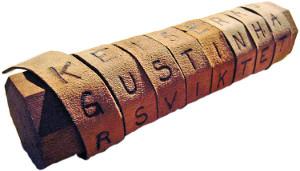

 |  |

A scytale (which rhymes approximately with "Italy"; and from the Greek $\sigma\kappa\upsilon\tau \acute \alpha \lambda\eta$ which means "baton") is a tool that can be used to perform a particular kind of transposition cipher.
To encrypt a message with a scytale, one takes a cylinder and winds a strip of parchment or leather around it. The message is then written upon this wound strap, where consecutive letters land on consecutive windings, as shown in the picture above.
The ancient Greeks, and the Spartans in particular, are said to have used this cipher to communicate during military campaigns.
The recipient uses a rod of the same diameter on which he wraps the strip of leather or parchment to read the message. This method of encryption has the advantage of being fast and not prone to mistakes -- a necessary property when on the battlefield. It can, however, be easily broken. Since the strip of parchment hints strongly at the method, to increase security the ciphertext should be transferred to something less suggestive, although this of course reduces the advantages previously mentioned.
The rail fence cipher is a transposition cipher where the ciphertext is found from the plaintext in the following way. First, the plaintext is written diagonally downwards on successive "rails" of an imaginary fence, then moving up when the bottom rail is reached. When the top rail is reached, the message is written downwards again until the whole plaintext is written out. The ciphertext is then read off in rows. For example, if 3 "rails" are chosen and the plaintext message is "send more troops", we would first construct the following rails:
S . . . M . . . T . . . P . . E . D . O . E . R . O . S . . N . . . R . . . O . . .
Then, reading across each row produces the ciphertext "SMTPEDOEROSNRO"
The key in a rotation cipher is composed of the block size and the rotation angle. It can be rotated to the left or to the right by 90°, 180° or 270°. If the text "attack at seven pm" should be encoded and we have a block size of 5, then the text is assigned to blocks like this:
ATTACKATSEVENPM
The result after the aforementioned possible rotations are shown below. The ciphertext is given by each row, in order, in the result. Note, each rotation yields a different ciphertext that could be used.
90° 180° 270° --- ------ --- VKA MPNEV CEM EAT ESTAK ASP NTT CATTA TTN PSA TAE MEC AKV
These rotated blocks produce the following possible ciphertexts:
90° : VKAEATNTTPSAMEC 180° : MPNEVESTAKCATTA 270° : CEMASPTTNTAEAKV